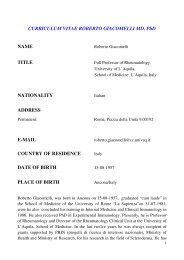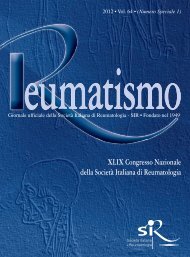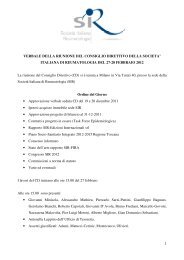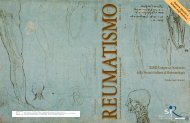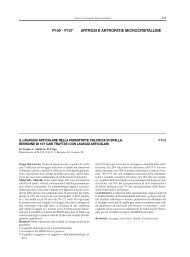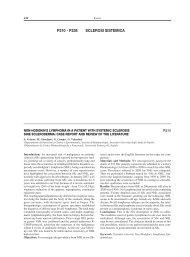M. Mosca (Pisa), R. Perricone (Roma) - Sir
M. Mosca (Pisa), R. Perricone (Roma) - Sir
M. Mosca (Pisa), R. Perricone (Roma) - Sir
You also want an ePaper? Increase the reach of your titles
YUMPU automatically turns print PDFs into web optimized ePapers that Google loves.
138 Comunicazioni<br />
DETECTION OF IGG/IGM ANTIBODIES THAT RECOGNIZE EPITOPE GLY40-ARG43 IN DOMAIN I<br />
OF BETA2GPI WITH AN ELISA ASSAY: A NEW PERSPECTIVE IN PREDICTION OF THROMBOTIC<br />
MANIFESTATIONS IN ANTIPHOSPHOLIPID SYNDROME?<br />
V. De Angelis 1 , G. Van Os 2 , F. Pregnolato 4 , C. Grossi 4 , C. Chighizola 1 , M. Biggioggero 1 , P.G. de Groot 2 , R.H.W.M. Derksen 3 ,<br />
P.L. Meroni 1,4 , R.T. Urbanus 2<br />
1<br />
Rheumatology and Clinical Immunology, University of Milan; 2 Departments of Hematology, University Medical Center Utrecht,<br />
The Netherlands; 3 Departments of Rheumatology and Clinical Immunology, University Medical Center Utrecht, The Netherlands;<br />
4<br />
Rheumatology and Clinical Immunology Unit, Istituto Auxologico Italiano of Milan<br />
Figure 1<br />
Background: Antiphospholipid antibodies (aPL), serological<br />
markers of the antiphospholipid syndrome (APS), are mainly directed<br />
against â2-glycoprotein I ( 2GPI), a plasma protein with<br />
phospholipid binding properties. 2GPI consists of five complement<br />
control protein or ‘sushi’ domains (designated I to V),<br />
that are arranged in an elongated, fish-hook shape. Although the<br />
location of epitopes recognized by aPL remains the subject of<br />
controversy, several studies suggest pathological aPL are directed<br />
against the Gly40-Arg43 epitope in domain I of 2GPI.<br />
Aim: To determine the specificity of assays that detect antibodies<br />
against domain I or domain IV of 2GPI for the diagnosis<br />
of APS, as well as their predictive value in the clinical<br />
outcome of the disease.<br />
Materials and Methods: We tested plasma or serum samples<br />
of 39 primary APS patients, who fulfilled the Sapporo criteria,<br />
9 patients with APS secondary to autoimmune connective tissue<br />
disease, 6 asymptomatic aPL positive patients and 8 asymptomatic<br />
patients with autoimmune connective tissue disease.<br />
We determined the presence of aPL (lupus anticoagulants, anticardiolipin<br />
and anti- 2GPI antibodies), as well as serological<br />
markers for autoimmune connective tissue disease. Patients<br />
with paraproteinaemia (10), hypergammaglobulinaemia (10),<br />
infectious disease (22) such as HIV (4) or hepatitis B (3) and<br />
-C (15), and autoimmune diseases without aPL (35) were used<br />
as controls. IgG- and IgM anti-domain I and domain IV antibodies<br />
were detected with a home-made assay. Cut-off values<br />
were set at the 99th percentile of 50 healthy subjects.<br />
Results: 52 patients with aPL were positive for IgG - and 31<br />
for IgM- anti- 2GPI antibodies, of which 21 (40%) were positive<br />
for anti-DI IgG and 10 (32%) for IgM. Only 9 (17%)<br />
were positive for anti-DIV IgG with 10 (32%) positive for anti-DIV<br />
IgM. 70 % of the patients with anti-DI antibodies had<br />
thrombotic events in their clinical history. Anti-domain I and<br />
domain IV antibodies were only detected in patients with anti-<br />
2GPI antibodies. None of the controls had anti-domain I o<br />
IV antibodies, but 5 samples positive for IgM anti-domain IV.<br />
Conclusion: APS samples display reactivity against epitopes<br />
in both domain I and domain IV of 2GPI. Anti-DI antibodies<br />
correlated with a clinical history of thrombotic manifestations.<br />
Keywords: Antiphospholipid syndrome, Anti-domain I beta2<br />
GPI, Anti-domain IV beta2 GPI.<br />
ANTICORPI ANTI-SU NELLA SINDROME DA ANTICORPI ANTI-FOSFOLIPIDI PRIMARIA (PAPS)<br />
A. Ceribelli 1 , I. Cavazzana 2 , A. Tincani 2 , R. Cattaneo 2 , F. Franceschini 2 , E.K.L. Chan 3 , M. Satoh 4<br />
1<br />
Cattedra di Reumatologia, Università degli Studi, Spedali Civili, Brescia; 2 U.O. Reumatologia, A.O. Spedali Civili, Brescia;<br />
3<br />
Department of Oral Biology, University of Florida, Gainesville, FL, USA; 4 Department of Pathology, Immunology and Laboratory<br />
Medicine, University of Florida, Gainesville, FL, USA<br />
Introduzione: Otre il 30-40% delle PAPS presenta anticorpi<br />
anti-nucleari (ANA), la cui specificità è solo raramente identificabile<br />
(anti-Ro/SSA, anti-lamine nucleari, anti-nucleosomi).<br />
Gli anticorpi anti-Su sono riportati nel 20% dei pazienti<br />
con Lupus Eritematoso Sistemico (LES).<br />
L’antigene Su è un complesso proteico di 100/102 e 200 kDa,<br />
identificato con la proteina “human Argonaute2 (hAgo2)”,<br />
coinvolta in meccanismi di trascrizione genica, spesso riscontrata<br />
all’interno di complessi citoplasmatici detti “GW bodies”<br />
(GWBs).<br />
Scopo del Lavoro: Determinare la prevalenza di anticorpi anti-Su<br />
e di altre specificità ANA, valutandone le correlazioni cliniche<br />
e di laboratorio, e l’eventuale rischio di evoluzione da<br />
PAPS a LES.<br />
Metodi: I sieri di 52 pazienti affetti da PAPS, afferenti alla nostra<br />
U.O. di Reumatologia degli Spedali Civili di Brescia, sono<br />
stati studiati per la ricerca di anticorpi anti-nucleari, con una<br />
metodica di immunoprecipitazione (IP) su cellule K562 radiomarcate.<br />
Gli stessi sieri sono stati studiati con immunofluorescenza indiretta<br />
(IFI), per analizzare il pattern ANA e la presenza di<br />
GWBs, e con tecnica ELISA con proteina Ago2 ricombinante,<br />
per confermare la presenza di anti-Su specifici per hAgo2.<br />
Risultati: Anticorpi anti-Su sono stati individuati in 7 su 52<br />
sieri (13.4%), anticorpi anti-Ro/SSA in 4 (7%) e anti-La/SSB<br />
in 1 (2%).<br />
La positività anti-Su mediante IP è stata confermata con tecnica<br />
ELISA in tutti i 7 sieri.<br />
Nella maggior parte dei sieri, le specificità anticorpali rilevate<br />
erano singole, solo in 1 caso gli anti-Su erano associati ad


